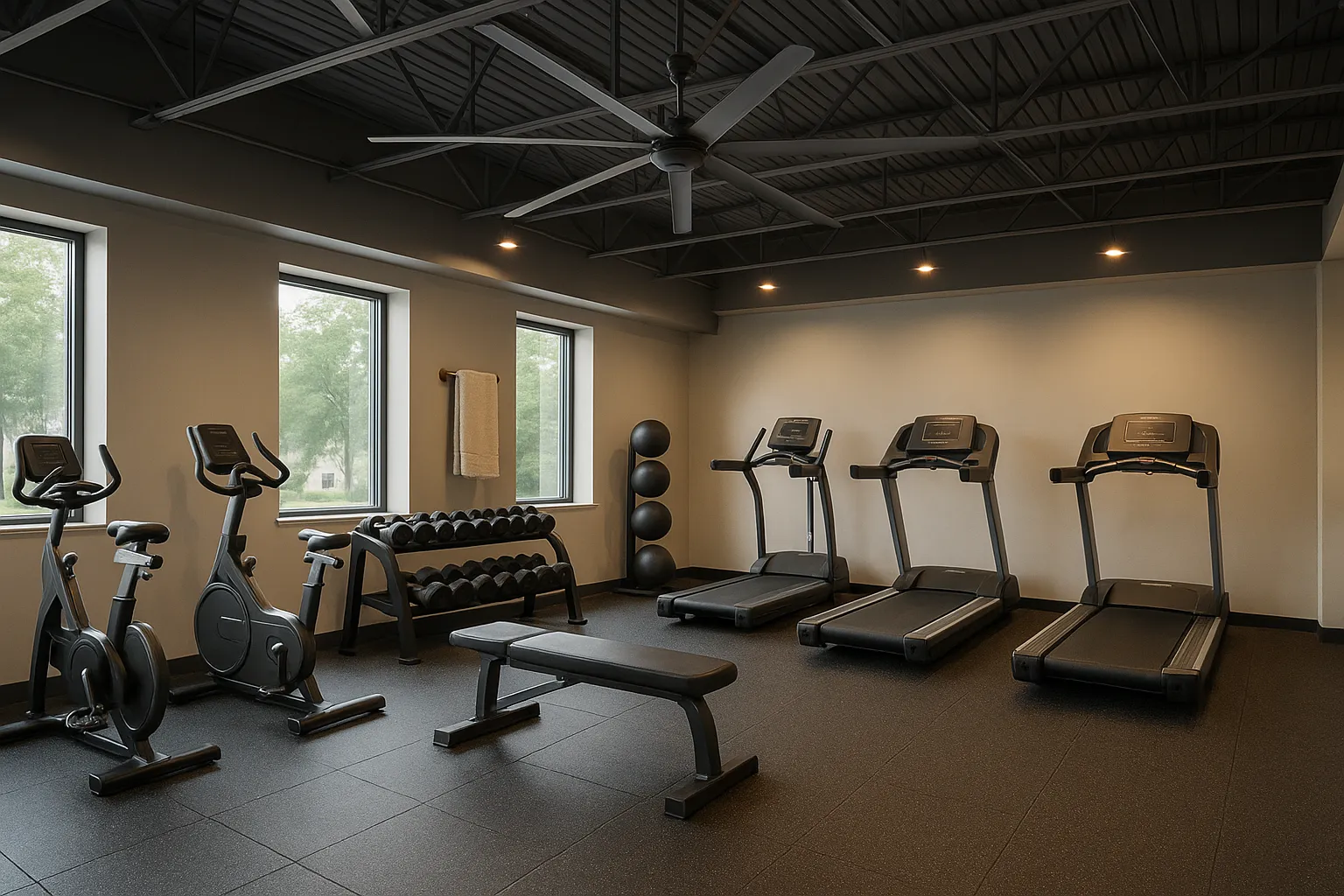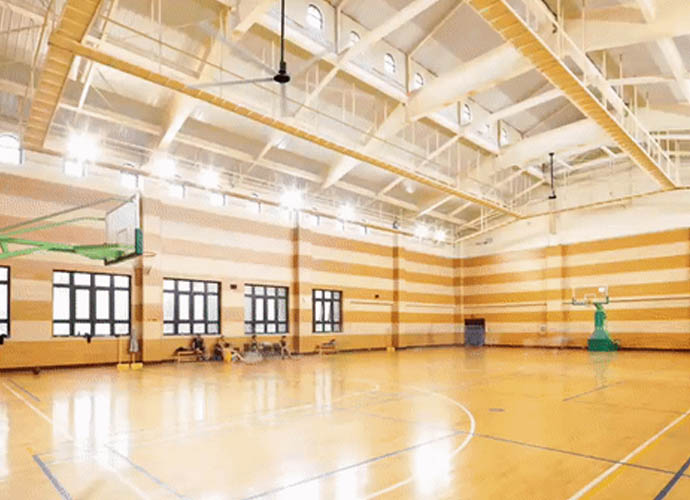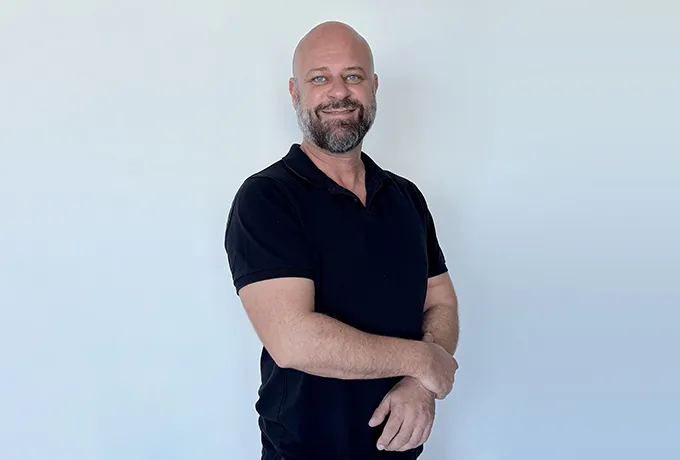Hot, stuffy academia floors slow people down. Add sweat, noise, and stale air, and motivation drops fast. HVLS solves this by moving big air gently, so your space feels legal and fresh without a huge energy bill.
O best fans for gyms são Ventiladores de teto HVLS that move high volumes of air at low speed to improve comfort, reduce heat stress, and boost eficiência energética. In fitness facilities com high ceilings, esses commercial gym fans destratify heat, support ventilação, and work alongside ar condicionado to create a steady, efeito de resfriamento at low operating cost.

hvls ventoinha de teto nos centros de fitness
Large gyms have big volumes to condition. Fãs HVLS (high-volume, low-speed) push volumes de ar gently across the floor, so people feel cooler while training. These ceiling fans are designed to move a huge volume de ar without creating drafts that interrupt workouts or classes.
Tradicional ventiladores de chão ou oscillating fans blow hard in one spot. Ventiladores de teto HVLS sweep the entire room, balancing circulação de ar e movimento do ar. Because fans help sweat evaporate, they create a cooling effect that feels like a temperature drop, even when the thermostat stays the same.
“Ceiling fans are a great way to support comfort in big rooms because they mix the air and cut the feeling of heat.” — Facility Engineer, community fitness center
Think by fluxo de ar, not just horsepower. Large group studios, free-weight zones, and courts benefit from 2–4 air changes per hour of mixed air. That’s where HVLS shines: one grande fã can cover grandes espaços that would otherwise need many pequenos fãs.
Relative Airflow (illustrative):
| Fan Type | Relative CFM Range |
|------------------------- |-------------------:|
| Box fans | #### |
| Pedestal fans | ######## |
| High-velocity fans | ########### |
| HVLS ceiling fans | ################## |
(CFM ranges vary by model. Chart shows relative scale only.)
Para um large gym, sizing is about diameter and placement, not just watts. Large diameter ceiling fans (typically 12–24 ft / 3.6–7.3 m) cover more floor area with fewer units, especially under high ceilings.
Quick sizing guide (rule-of-thumb):
| Gym space (approx) | Altura do teto | Typical fan diameter | Notas |
|---|---|---|---|
| Studio / 4,000–8,000 sq ft | 16–25 ft | 12-16 pés | One unit may cover the space |
| Court / 8,000–15,000 sq ft | 20–35 ft | 16–20 ft | Two units for even coverage |
| Arena / 15,000+ sq ft | 25–50 ft | 20–24 pés | Grid layout for uniform airflow |
When in doubt, escolhendo o ventilador certo means mapping obstacles (lights, beams), confirming teto structure, and checking clearances for safe blades and teto hardware.
Explore mid-to-large diameters in the M650 series of Ventiladores de teto HVLS for balanced coverage in workout areas and courts (high-performance HVLS fans).
Conventional fans are useful, but each type shines in different spots.
| Opção | Pontos fortes | Consider if… |
|---|---|---|
| Box fans | Low cost, portable | You need spot cooling for staff desks or corners |
| Fãs de pedestal | Adjustable height & aim | You’re covering small zones or temporary setups |
| High-velocity fans | Strong, focused jet | You need intense airflow for short, targeted bursts |
| Ventilador HVLS | Wide mixing, quiet, low watts per CFM | You want whole-room comfort and eficiência energética |
Os fãs se movem heat off the body; fãs correm cheaply compared to compressors. In most gym environments, HVLS fans offer the broadest coverage with the fewest units. For spec-driven projects, compare the volume of airflow (CFM), diameter, motor type, and controls on performance pages like the M750 lineup (best HVLS fans for coverage).
Sim. Ceiling fans help seu ar condicionado by mixing cool supply air with warm air near the teto. Esse ventilation and air mixing reduces hot spots and “stale corners,” so the system can meet setpoint with less strain. In simple terms, os fãs podem reduzir run time for compressors and help maintain a steady efeito de resfriamento throughout the gym.
Muitos grandes ventiladores de teto comerciais integrate with building controls for setpoint trim and seasonal logic. See how big systems coordinate in edifício comercial deployments (large commercial applications).
Start by sketching zones: free weights, cardio, turf, courts, and lobby. Place gym ceiling fan centers to avoid obstacles and keep blade tips clear of lights and scoreboards. Under high ceilings, aim for 10–15 ft from blade to floor for best coverage.

HVLS FAN IN GYM
Em fitness environments, reliability is king. Ventiladores de teto industriais use robust hubs, blades, and mounts to handle vibration and long hours. This grau industrial approach keeps fans stable and quiet, even above free-weight areas and tracks.
You’ll also see better results when os fãs são projetados for continuous service. Look for tested mounts, redundant safety cables, and UL compliance. In short, industrial ceiling fans and air management go together—quiet operation keeps classes focused and coaches heard.
A mid-size facility (two basketball courts + training room) had high ceilings and stuffy corners. Two large gym fans over the courts and one unit in the training room improved comfort at low speed. Staff reported fewer hot spots and a calmer noise floor.
For sports halls and arenas, see dedicated gyms and fitness centers coverage guidance (sports-center solution overview).
Here’s a simple path to be sure the fan is the right fit:
If you want a single fan for your gym, model selection tools make this fast. Brands you may know—Hunter Industrial e MacroAir fans—popularized the category; a specialized HVLS manufacturer can fine-tune blades and controls for your exact court layout. (Mention of brands is for context, not endorsement.)
Focus on the parts that affect comfort and power draw:
Explore spec pages to compare Ventiladores de teto HVLS, including corrosion-resistant and ventilador de teto suspenso galvanizado options for special environments (project-ready galvanized ceiling fan).
Absolutely. In spring and fall, fãs oferecem comfort with minimal energy. Ceiling mixing extends mild-weather days before you switch to full HVAC. In dry regions, pairing steady HVLS airflow with resfriamento evaporativo boosts comfort in training zones and side courts.
É aqui que ceiling fans and air circulators complement each other: use portable fan ou pequenos fãs near therapy tables, then let the overhead system circular o ar wall to wall.
Smart controls let fãs correm slower during low occupancy and ramp up before peak classes. Tie schedules to class calendars, or link to temperature sensors for dynamic setpoints. Fans like these respond smoothly, so coaches don’t notice changes mid-set.
Need quiet mornings in the fitness center but higher intensity in the court? Create independent “fan groups” to tune comfort throughout the gym. This is standard in soluções para ventiladores para gyms or fitness centers with mixed uses.
As an HVLS fans manufacturing plant, we design commercial fans for gyms with strong hubs, efficient motors, and safe mounts—built for the long days of the indústria de fãs. Our team maps your gym or fitness facility, checks structure, and proposes opções de ventilador and placement that make sense.
For deeper technical background or to review company credentials, see our HVLS fans manufacturer page (factory-direct engineering & support).
If your utility bills are rising and your teto is tall, start with industrial fans for gyms. O ar frio you feel from mixing often lets you raise the thermostat a little while comfort stays steady. In many projects, os fãs podem reduzir compressor cycles and lower overall costs.
For warehouses and cross-trained facilities with shared walls, grande comercial deployments show similar wins. See warehouse-scale examples to understand coverage math (useful for oversized weight rooms too) (warehouse HVLS overview).

Os melhores fãs no centro esportivo
And yes, ceiling fans are a great fit for multipurpose halls; adjust speeds for yoga vs. HIIT so people stay focused and gym cool.
What makes HVLS fans different from conventional fans?
They’re grandes ventiladores de teto that move a gentle, giant column of air. One unit covers wide zones, so you need fewer devices and less noise than conventional fans.
Will HVLS work with my current HVAC?
Sim. Teto HVLS systems mix air to support ventilation and air distribution. That helps the HVAC meet setpoints with less strain and a better efeito de resfriamento.
Are these safe over courts and weight areas?
Moderno ventiladores de teto industriais include tested mounts and safety tethers. Installers verify the teto structure and spacing before commissioning.
How loud are HVLS fans?
They’re quiet at working speeds—ideal for coaching and class instruction. Many systems are quieter than clusters of fãs de caixa ou high-velocity fans.
Where can I see options for sports spaces?
Check the sports-center solution page with project examples and specs (commercial ceiling fans for sports centers).
Do you offer models for manufacturing-adjacent gyms?
Yes, we apply similar hardware found in ventiladores de teto industriais for factories, tuned for fitness facilities near plant floors (ventiladores de teto industriais para a indústria transformadora).
If you need a tailored layout—studios, courts, lobbies—we’ll map airflow and confirm the fan is the right size and placement for your facility.

Olá, eu sou Michael Danielsson, CEO da Vindus Fans, com mais de 15 anos de experiência na indústria de engenharia e design. Estou aqui para compartilhar o que aprendi. Se você tiver alguma dúvida, sinta-se à vontade para entrar em contato comigo a qualquer momento. Vamos crescer juntos!